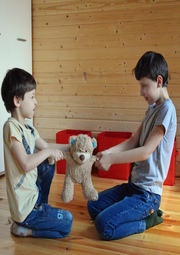How to Deal With Physical Aggression and Violence Between Kids
We like to think that little ones are innocent and incapable of overstepping the line, especially when it comes to violence and aggression. These may seem like issues that only impact adults, but the reality is that youngsters can exhibit potentially problematic behaviors that need to be understood and dealt with appropriately.
Here’s a look at what you need to know to recognize and overcome aggressive, violent behavior when it crops up, whether your child is directly responsible or the victim in an incident.
Recognizing the Signs of Physical Aggression in Children
Recognizing the signs of physical aggression in children is vital for timely intervention and effective resolution. Key warning signals include:
- Frequent escalation: Regular arguing evolving into physical altercations.
- Bullying: Targeting a specific child repeatedly, exhibiting dominating behavior.
- Isolation: Children feeling unsafe or unwilling to engage with their peers.
- Destructive tendencies: Deliberate damage to property or belongings of others.
- Sudden mood swings: Rapid and extreme changes in emotions, anger outbursts without clear triggers.
By identifying these signs early on, parents, caregivers and educators can better understand the underlying issues behind aggressive behavior and take appropriate steps.
Strategies for Reducing Conflict and Encouraging Empathy
Once you spot warning signals of unwanted violent undertones in children’s behavior, strategies for reducing conflict and encouraging empathy include:
- Teaching problem-solving: Equip kids with effective ways to resolve disputes without resorting to violence.
- Emotional regulation: Provide tools for managing anger, frustration, or any strong emotions that could lead to aggression.
- Role-modeling: Display positive behavior examples by solving conflicts constructively as adults.
- Fostering cooperation: Encourage teamwork and collaborative activities that promote understanding and mutual support.
- Reinforcing empathy: Cultivate an environment where children express care and concern for each other’s feelings, fostering empathetic connections.
Older Kids and Teens: Understanding the Law About Assault and Threat
Older kids and teens need to understand the law surrounding assault and threat to recognize that engaging in aggressive behavior could carry serious legal repercussions.
Parents should discuss potential criminal charges for violent actions, emphasizing their consequences within the community and judicial system. From fines and jail time, young adults have to connect the short and long term fallout from even minor altercations with their future freedom and happiness.
If facing such complications, defending against assault and threat charges in Monmouth County or any other jurisdiction might require seeking professional legal advice from an experienced attorney.
Empowering youth with this awareness may deter them from taking part in physical aggression or violence towards others.
Essential De-escalation Techniques to Address Violent Situations
If you’re the responsible adult in the room, you have a duty to get involved to prevent worrying conflicts between kids from bubbling over. Essential de-escalation techniques to address violent situations between kids include:
- Staying calm: Maintain a composed demeanor to encourage a sense of safety and stability.
- Verbal intervention: Use clear, concise language to communicate expectations and diffuse tension.
- Empathetic listening: Allow each child involved to voice their concerns or grievances without interruption.
- Avoiding blame: Focus on resolving the issue at hand instead of assigning blame or fault.
- Offering space: If needed, temporarily separate children physically until emotions subside.
In short, you cannot afford to be passive, but also have to recognize that you should not be pouring any fuel on the fire of a face-off, no matter the age of the individuals involved.
The Bottom Line
As with all kid-related concerns, it’s best to discuss issues of aggressive and violent behavior with children regularly, so that they are equipped with the knowledge they need, and so that you can steer them down the right path.




